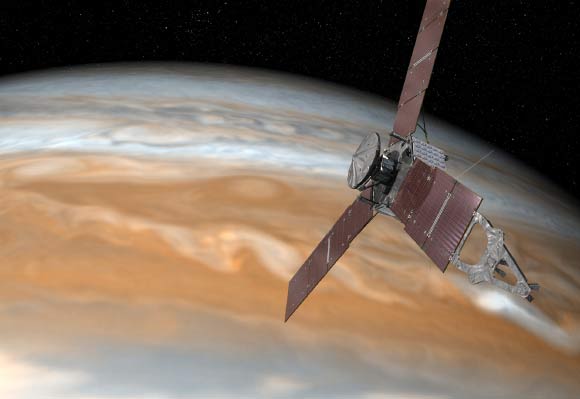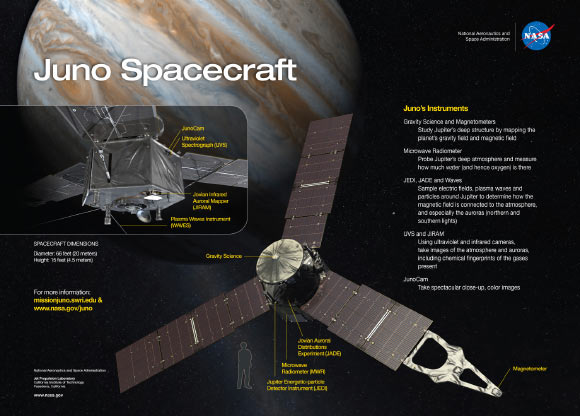Members of NASA’s Juno mission have been busying themselves, getting the spacecraft ready for operations in orbit around Jupiter.

This artist’s rendering shows Juno making one of its close passes over Jupiter. Image credit: NASA / JPL-Caltech.
After an almost five-year journey to the Solar System’s largest planet, Juno successfully entered Jupiter’s orbit during a 35-minute engine burn.
Confirmation that the burn had completed was received on Earth Monday, July 4, at 8:53 p.m. PDT (11:53 p.m. EDT, 3:53 a.m. UTC/July 5).
Juno will circle the gas giant 37 times for almost two years, observing the planet from its polar orbit, some 3,000 miles above its dense clouds.
It is the first spacecraft to orbit Jupiter since Galileo, which deliberately crashed into the planet in September 2003. Spacecraft have flown to Jupiter before, but none were equipped with the advanced technology and instruments on board Juno, instruments that will offer insight into the planet’s origins, structure, atmosphere, and magnetosphere.
As planned, Juno returned to high-rate communications on July 5 and powered up five of its science instruments on July 6.
Per the mission plan, the remaining science instruments will be powered up before the end of the month. Juno’s science instruments had been turned off in the days leading up to Jupiter orbit insertion.
The Juno team members have scheduled a short trajectory correction maneuver on July 13 to refine the orbit around Jupiter.
“We are in our planned 53.4 day orbit,” said Juno project manager Dr. Rick Nybakken, from NASA’s Jet Propulsion Laboratory.
“Now we are focusing on preparing for our fourth and final main engine burn, which will put us in our 14-day science orbit on October 19.”
The next time Juno’s orbit carries it close by the planet will be on August 27. The flyby is expected to provide some preliminary science data.
“We had to turn all our beautiful instruments off to help ensure a successful Jupiter orbit insertion on July 4,” said Juno principal investigator Dr. Scott Bolton, from the Southwest Research Institute.
“But next time around we will have our eyes and ears open. You can expect us to release some information about our findings around September 1.”








